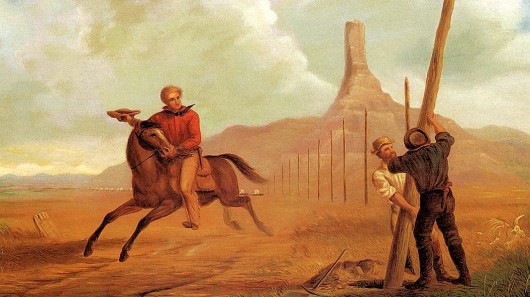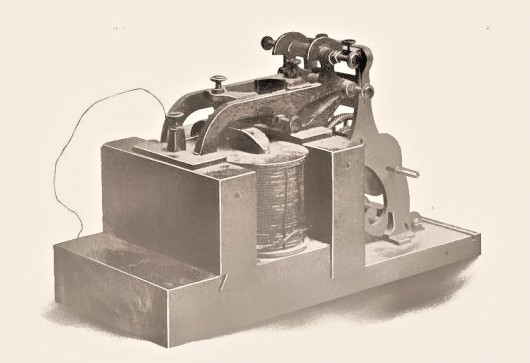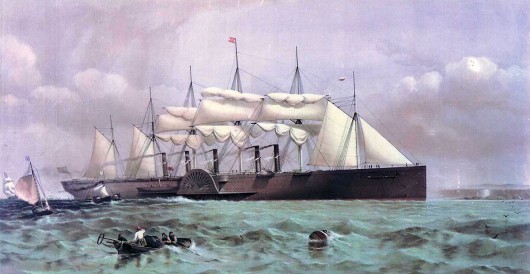
The Last Ride of the Pony Express - painted by George M. Ottinger in 1873 - showing a Pony Express rider passing the work crews installing the Transcontinental Telegraph (Photo: The Athenaeum)
After linking the world for 167 years, the commercial electric telegraph is no more. The speed with which electromagnetic telegraph systems took over both short- and long-distance communication in the mid 19th century set the pattern which telephones and the internet would follow, spawning the connected world we now live in. The closing down of India's state-run Bharat Sanchar Nigam, Ltd. (BSNL) network on Monday sparked a last-minute rush of people looking to send a souvenir telegram to mark the historic event before the electric telegraph was relegated to the history books.
In 1837, Samuel Morse, together with his assistant Alfred Vail and US physicist Joseph Henry, invented the single-wire telegraph. There were previous multi-wire telegraphs developed, but none proved commercially successful. Morse and Vail also developed the Morse Code during this period.
In 1844, Morse and Vail demonstrated their improved telegraph system over a federally-funded line stretching from Washington to Baltimore. The first commercial telegraph line became operational just two years later. The line connected Lancaster and Harrisberg, Pennsylvania, a distance of 39 miles (63 km). Where Morse's first message read "What hath God wrought?", the inaugural communication on the Pennsylvania telegraph was the somewhat less formal, "Why don't you write, you rascals?"
The subsequent pace of wiring the world via telegraph was quite remarkable. During the 1850s, most cities and towns in the eastern portion of the United States were connected by a web of telegraph wires. In 1861, the first transcontinental telegraph line spanned the US, providing instant communication between east and west coasts. Two days after the line went live, the Pony Express was dissolved as obsolete as it just couldn't compete with the much quicker delivery time of the transcontinental telegraph.
The installation of an underwater cable across the Atlantic Ocean that connected western Ireland and eastern Newfoundland was accomplished in 1858, only 12 years after the first commercial telegraph was founded. The hostile conditions encountered in the ocean depths (much of the cable lay at a depth of 2.5 mi (4 km)) were not well understood, resulting in a useful life of only three weeks for this first transatlantic cable. Progress in developing robust cables was rapid, however, with the first stable telegraph cable being laid in 1865-6.
Imagine the task of constructing and deploying such a cable. At the heart of the cable were seven strands of very pure copper wire. Each strand was about 1.2 mm in diameter. These strands were coated with Chatteron's compound (a mixture of gutta percha, rosin, and tar). Four thick layers of gutta percha (a crystalline latex rubber) were applied, with thin layers of Chatteron's compound between them. This core of the cable was covered with a jacket of specially preserved hemp, then wrapped with twelve strands of 2.4 mm diameter high-tensile steel wire, protected from corrosion by galvanization and covered with treated hemp yarn. The resulting cable is just over an inch (25 mm) in diameter, and weighs about two tons per nautical mile (a kg per m).
Some 2,300 nautical miles (4,300 km) of cable with a weight of about 4,600 tons (4,173 tonnes) were required to lay the transatlantic cable across the North Atlantic seafloor. At the time, the largest sailing steamship in the world was the SS Great Eastern, a ship which was laying idle owing to a rather tempestuous life at sea. She had suffered a major explosion, had been torn apart by gales and rocks, had a habit of running down and sinking smaller ships, and rarely sailed with even a significant fraction of the 4,000 passengers for which she was designed. In the end, a price war with the Cunard and Inman shipping lines forced her out of the market.
What the transatlantic cable companies saw, however, was that the world's largest ship could be bought at auction for a fraction of her value, a mere £25,000 (US$38,000) for a ship whose scrap value alone was four times greater than that. After refitting, the SS Great Eastern became the first large-scale ship dedicated to the laying of underwater cables, eventually laying over 30,000 miles (50,000 km) of cable at a pace of 5 mph (8 km/h).
The reliable transmission speed of the 1866 transatlantic telegraph system was eight words per minute, reflecting the tendency of these early cables to spread a waveform in time, so that input pulses spread out and could overlap at the receiver if sent too quickly. In 1885, Physicist Oliver Heaviside provided the knowledge that allowed changes to the design of the cables to overcome this problem, so that by 1900 transmission rates of 120 words per minute were being sent reliably between continents.
The cost of early telegrams were only justified by the value of instant communication. In 1860, for example, a ten-word telegram sent from New York to New Orleans cost $2.70 (about $65 in 2012 currency). When the transcontinental telegraph opened, the cost was $7.40 for ten words (about $210), while a ten word transatlantic message to England cost $100 (about $2,600). These prices came down in time, but telegrams largely remained a tool for the corporate, the rich, and for emergencies. Despite the high cost, some 212 million telegrams were sent in the US in 1929, the peak year for such activity.
The high cost of telegraphic messages led to many expedients to reduce the word count of telegrams. As abbreviating words did not help (telegrams were charged by the word, with a ten word minimum), other elements of cryptography were enlisted. One favorite, particularly for businessmen, was the use of private codes. Code books were available containing lists of phrases and the corresponding code, typically containing about five characters.
For example, the message "What is the best price delivered here for axle steel? How long does the quotation hold good? Disposed to accept any reasonable offer. Anxiously awaiting your reply. Rodgers." in the private code of the US Steel company would read "QKKMA AFBEH QPXFL QRURH QSWKU Rodgers."
Along the same lines, the shortest known telegraphic query and answer was between Oscar Wilde, the Irish poet and playwright, and his publisher. Wilde, who was living in Paris for the sake of his freedom, was curious one day about the sales of his new book in England. He cabled his publisher "?" and "!" was the quick response.
As the 20th century progressed, increasing access to, and decreasing prices for, telephone communications began to reduce the importance of telegraphy. In 1960, the cost of a three-minute phone call and a 15-word telegram were approximately equal in the US. As the prices crossed, the number of telegrams sent in 1970 was about half of the number sent in 1960, and continued to slide as other forms of electronic communication multiplied.
At about the same time, the wired telegraph was beginning to be replaced in most First World countries by wireless microwave systems, and later by satellite systems. The telegraph system operated in India by BSNL was the last system known to use wired telegraphs. But the popularity of email and mobile phones had seen the system running at a loss for years.
The last telegram sent in India was from Ashwani Mishra, a reporter for India's DD News TV channel, to Rahul Gandhi, the Vice President of the Indian National Congress. The telegram wished Mr. Gandhi, the grandson of Indira Gandhi and the great grandson of Jawaharlal Nehru, success and happiness in life, and hopes that he would attain the heights in life as did other great men of the past.
While one can still send telegrams in many countries, for the most part the data is transmitted over internet links. The electric telegraph is now a subject for nostalgia and hobbyists, who still string local telegraph systems for chatting via Morse code.
Sources: Bharat Sanchar Nigam, Ltd., Times of India, EH Net and Atlantic-Cable
Copyright © gizmag 2003 - 2013 To subscribe or visit go to: http://www.gizmag.com



